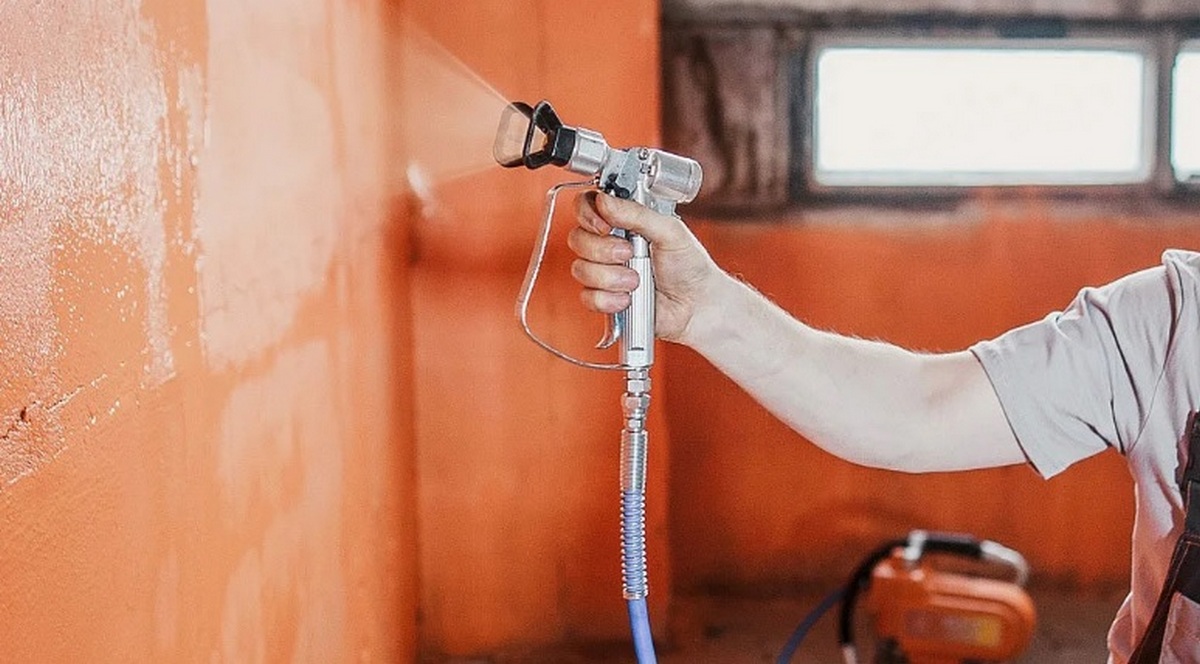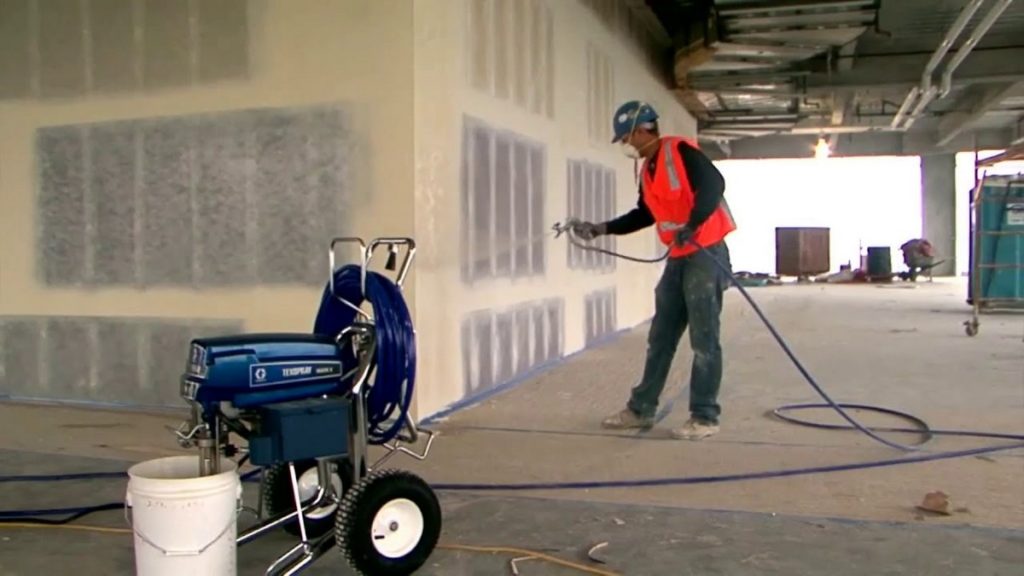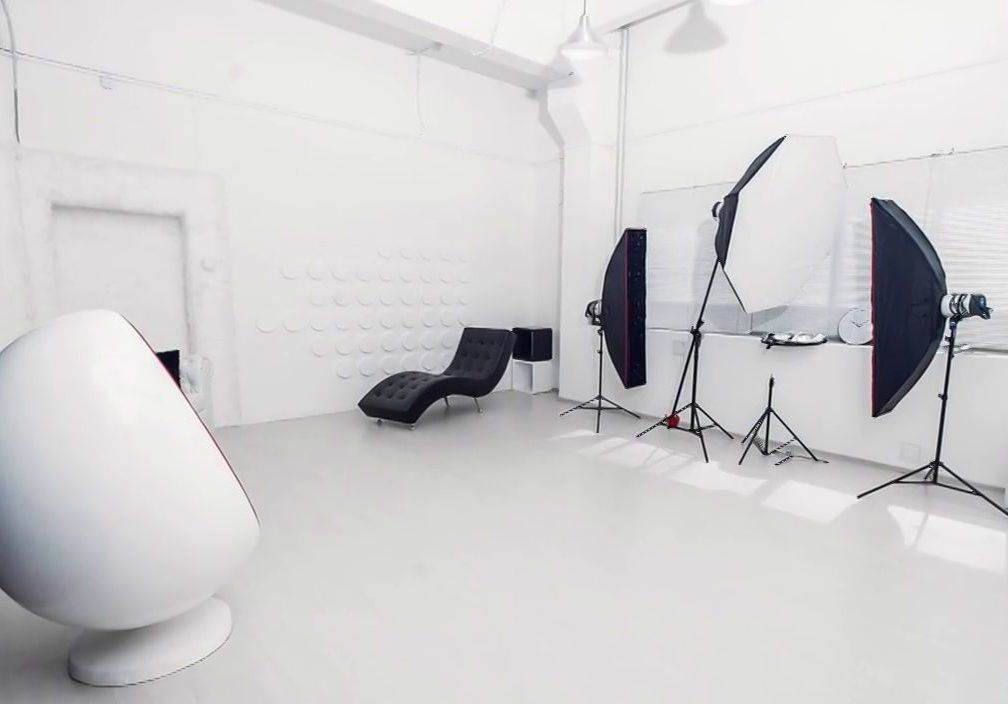Rating of the best painting installations (painting machines) for 2022

When choosing painting equipment, first of all, you should decide on the scope of future work, as well as how often you will have to use this equipment. The type of equipment needed and its power will directly depend on these parameters. In principle, most models of this equipment can be conditionally divided into professional and household.

Content
- 1 Household and professional painting equipment
- 2 Scope of application and main types of airless painting machines
- 3 Accessories for painting equipment
- 4 Difficulties of choice
- 5 Rating of the best painting installations (painting machines) for 2022
- 6 Instead of an epilogue
Household and professional painting equipment
Naturally, if you plan to use the device a couple of times a year, and even then only to paint a bench or a fence in the country once, then there is no point in spending money on an expensive professional option. And, on the contrary, if the equipment is used on an ongoing basis and for professional work, then a simplified household sample simply cannot cope with the loads typical for such volumes. At the same time, the type of consumables used (paints) and general working conditions (weather, permanent power supply, etc.) should be taken into account. Thus, various spray guns are suitable for domestic use, and for professional work it is better to use high-pressure paint equipment or airless equipment. With the help of the latter, it is easy to paint surfaces over a large area, because this technique has high performance indicators. In general, professional installations are mostly used in mechanical engineering, construction, and in the restoration and architectural business.
Household models usually work with paints and varnishes of a low degree of viscosity, and therefore do not need to issue particularly high powers. They work from a standard electrical outlet and their principle of operation is to simply spray the coloring mixture.They are distinguished by their relative cheapness and the ability to cope with small amounts of work in the field of painting.
Professional models include high-pressure installations, with airless spraying of membrane or piston type. This equipment has a fairly high capacity and is capable of spraying a variety of different materials - from lime whitewash and primer to metal flame retardants, zinc paints, enamels, epoxy compounds and putty. In addition to standard building mixtures, professional equipment can spray stains, varnishes, impregnations. Even in agriculture, they can be used: they can also be used to treat plants with chemicals.
Scope of application and main types of airless painting machines
Modern types of painting machines can be used to perform the following operations:
- Application of waterproofing compounds;
- Application of flame retardants;
- Application of compositions for anti-corrosion protection;
- Texture coating;
- Finishing painting of wooden objects;
- Automotive painting;
- Application of polyurethane foam and other materials with hardening up to 5 seconds after kneading;
- Drawing markings on the roadway;
- Finishing electrostatic painting.
Airless spray painting equipment has established itself as the most economical, user-friendly and productive group of devices. With their help, large volumes of work are easily performed, although they can also be used for minor cosmetic repairs.The main advantage of this category of devices lies in the fact that, despite their efficiency, they give out a high quality of object coloring - the result of the work will be a uniformly applied layer of paint. All this is achieved by supplying the dye under high pressure.
Various variations of airless equipment can adjust the saturation of the spray, which will allow you to control the flow of the coloring substance, set the pressure level and control other parameters. From this it is clear that by adjusting the settings it is possible to paint both a large and long fence and a small and narrow window frame equally well.
As a special advantage of airless technology, professional painters highlight the possibility of its work with materials of increased viscosity. A standard spray gun, for example, is not adapted to work with such materials and its design will easily become clogged with consumables and become unusable. An airless machine, using high pressure, will properly spray the viscous mass, creating a thick and even layer on the surface to be painted.
Airless models may differ in:
- Type of drive - the device can operate on the basis of an electric motor, an internal combustion engine or a pneumatic drive;
- Type of working element - piston or membrane machines.
Membrane technology
Such devices have a special diaphragm pump and are mainly used to work with not too viscous or completely liquid paints, oriented to the treatment of any surface (concrete, brick, wood, metal).The pump of these machines has a special design: the motor sets the rotation of the shaft, which is equipped with an eccentric, and as a result, the rotational movement of the shaft is transformed into the translational movement of the piston. The piston, in turn, pushes the membrane, which creates a rarefied atmosphere in the pressure chamber, whereby the dye is drawn. Further, the paint is fed through the valve to the spray gun, but if the trigger on it is not pressed, then the paint returns to the collection container.
Membrane equipment has become popular due to its low price, technical simplicity and overall reliability. Even a novice painter with minimal experience is able to work on such a device. Depending on the conditions of future work, the membrane apparatus can be equipped with a fuel or electric motor. Naturally, if you have to work in a fire-explosive production, then it is preferable to use equipment on an electric motor (such samples are marked with the letters "EX"). Fuel models are suitable for work in areas where there are no power sources.
The advantages of membrane machines for painting include:
- Resistance to surges and voltage drops, because there is no electronic control in pumps of this type and most of the functionality depends on hydraulics;
- Compared to piston models, membrane models tolerate “contaminated” ink material better due to their plastic membrane;
- Their pump parts are fairly cheap (the diaphragm itself and exhaust/intake valves are cheaper than a similar piston repair kit).
At the same time, the disadvantages of membrane devices include:
- It is very difficult for a plastic membrane to pump substances that have even an average degree of viscosity, and very viscous substances will certainly have to be diluted;
- Membrane devices are prone to pulsations when spraying coatings on some types of pumps, if hoses with a narrow section or short length are used;
- If the equipment runs for a long time without interruption, then the motor will begin to create excessively strong vibrations.
Piston technology
Immediately it is worth mentioning the qualitative advantages of piston machines, which include:
- They are better than membrane ones, they are adapted to work with substances of increased viscosity;
- They make less noise during operation due to the fact that when the right amount of dye is pumped by the pump, it stops the circulation of the latter (which is not the case in membrane models);
- If clean filtered coatings are used, then the service life of the entire structure and its working parts increases significantly.
At the same time, this technique also has a number of disadvantages:
- It is very sensitive to voltage surges and drops, therefore, for the proper operation of its electronic control unit, a voltage stabilizer should be used;
- It has a very high price when compared with membrane devices;
- There is a need to constantly filter the paint before using it.
On an electric motor
Electric piston devices are excellent for working with viscous and medium-viscosity substances. If in membrane machines the intake of the coloring matter was carried out by a membrane, then in this case the piston serves as a working element. It produces forward-return movements, thereby sucking the beauty out of the intake tank.The electric motor is connected to a piston mechanism, which transforms the energy from the rotation of the engine axis into forward and backward manipulations of the piston.
IMPORTANT! Electric piston technology is not intended for super-viscous paints, but this does not prevent it from being used for applying putty and plaster. For appropriate operations, the viscosity of the substance used must be taken into account.
Hydraulically driven
Hydraulic driven machines are designed to operate in difficult conditions and can handle very thick formulations. The basis of their design is a hydraulic pump, which can be driven by an electric motor or a fuel engine. This functioning system allows the piston to perform no more than 40 cycles per minute, and this significantly increases productivity and allows the application of texotropic paints of increased viscosity. At the same time, operating pulsations are reduced to a minimum level, which ensures constant pressure throughout the system.
IMPORTANT! With permanent manual adjustment, premature wear of the working elements of the structure may occur. In hydraulic samples, this situation can be avoided due to the operation of the automatic adjustment system for the movable seal pack, as well as due to the coating of the intake tank with a wear-resistant composition. All bases that come into contact with paintwork materials are made of stainless high-quality materials and are resistant to the negative effects of chemically aggressive and abrasive substances.
With piston hydraulic models it is possible to apply anti-corrosion protection, epoxy resins, refractory and bituminous mixtures.
Pneumatic driven
Pneumatically driven equipment is used for industrial work with thick and liquid substances. The main advantage of such devices is that they can be used at hazardous facilities with a high degree of fire and explosion safety.
The working part is presented in the form of a piston pump operating on the efforts of a pneumatic drive. When compressed air is supplied through the reducer, it is supplied in turn to the upper and lower compartments of the air motor. As a result, the pump plunger together with the piston rod produce translational-return movements. The plunger and valve system form a discharged atmosphere and the paint is fed into the body. When moving in the opposite direction, the clan is closed, and the coloring substance under high pressure passes through the hose to the spray gun. Thus, thanks to such a system, it is possible to use piston pneumatic devices with both liquid and superviscous consumable coloring materials.
IMPORTANT! For pneumatic models, in order to improve the quality of painting, it is recommended to adjust the spray pattern with air flow.
Marking equipment
These machines also belong to the group of airless painting equipment and are used for marking the roadway. Most often they are bulky devices installed on the basis of ordinary heavy vehicles, but today there are also small-sized mobile variations that cost much less. The latter, as a rule, have a gasoline internal combustion engine, have a wheel frame with a control console and a pistol-type sprayer.
Their nozzle can be different in diameter, which makes it possible to apply different marking lines.Through airless spraying, the pattern on the road is smooth and clear. Depending on the selected sample, you can apply different types of markings - from the usual two-lane to curly. The machines described are commonly used for road marking, football field processing, parking lot markings, and in large shopping malls (to indicate the direction of travel).
Accessories for painting equipment
In addition to the painting installation itself, additional work items will be required for full-fledged work. They are able to increase the functionality of the device, increasing its productivity, while facilitating the work of the operator. These include:
- Nozzle holder - with its help it is possible to qualitatively fix the nozzle in the desired position (traditionally sold together with a seal for a tight connection).
- Nozzle-flag - with its help, the operating mode is indicated and regulated. To switch, you need to rotate the flag 180 degrees. It has a three-level marking, where each level indicates the diameter of the nozzle and the spray angle. The diameter must be selected depending on the viscosity of the coloring matter, i.e. the thicker the paintwork, the larger the diameter should be.
- Extension - this nozzle is used for staining hard-to-reach places. It is a kind of fishing rod: a long aluminum tube, at one end of which there is a nozzle holder, and at the other - a fixing nut.
- Nozzle for painting pipes from the inside - the device has special guides for centering the nozzle inside the pipe.
- Heater - this element is needed to heat the compositions of increased viscosity.
- Filter - with its help it is possible to obtain the proper level of spraying of the composition, while cleaning it;
- Hose - with its help, you can increase the high-pressure line to the required length (usually, a paint installation is able to supply paint over a horizontal distance of up to hundreds of meters).
Difficulties of choice
As professionals say, the selection of a painting installation cannot be reduced to a completely clear and harmonious algorithm, because different manufacturers include various options in their models that can either be duplicated or simply absent in seemingly similar devices. The same can be said about completely simple machines and highly specialized installations.
However, the purchase of a painting installation must be preceded by a thorough analysis of future working conditions. High-altitude painting can be called work with difficult operating conditions, because in this case the machine will need to have an appropriate range of paintwork supply and it will not be superfluous to provide it with a set of additional nozzles.
Another important factor will be the intensity of future work, its overall frequency, as well as the type of coloring consumable used frequently. From this it is clear that under certain conditions the apparatus may need a device for heating the consumable mass, a device for mixing several components for spraying, etc.
It will not be superfluous to take care of the quality of the brand-manufacturer. Semi-professional models from a little-known brand are hardly suitable for permanent and intensive work.
Rating of the best painting installations (painting machines) for 2022
Budget segment
3rd place: "Patriot SG-110"
A simple, cheap, but effective model that is in high demand among buyers. It is characterized by a moderate consumption of coloring agents, without losing the quality of application.It has an extended service life, because the body is made of durable plastic, it is extremely resistant to mechanical stress. The paint container has a volume of 0.8 liters, is powered by the mains, spraying is carried out in a circle, there is a paint supply setting. The established cost for retail chains is 2200 rubles.

- Economic consumption of LKM;
- Sufficient performance;
- Long service life.
- Little power.
2nd place: "Pobeda KP-300"
Inexpensive model from a domestic manufacturer, very convenient to use. Able to spray the material well on the surface, because it has sufficient power and performance. Spray flow rate is adjustable. The comfort of work is reached at the expense of an ergonomic handle. The type of power supply is from the mains, the volume of the container for paintwork materials is 0.8 liters, spraying is carried out in a circle. The total weight of the device without a filled container is 1.3 kilograms. The recommended cost for retail stores is 2300 rubles.

- Easily works even with large areas;
- Adequate cost;
- Ergonomic handle.
- Not suitable for finishing.
1st place: "Sturm! SG9612"
A quality device from a German manufacturer, with a more than adequate cost. Users rightly appreciated the ease of use. When working, the paint does not splatter in all directions, but evenly falls in a directed place. The machine is characterized by a reasonable consumption of coloring matter. Can be used to apply medium viscosity paint. It has a large capacity of 1 liter. It has adjustments for the supply of paintwork materials, is powered by the mains, the total net weight is 2 kilograms.The recommended cost for retail chains is 2500 rubles.

- High-quality application of coatings;
- Economic consumption of material;
- Ability to work on ceilings.
- There may be problems with the purchase of spare parts.
Middle price segment
3rd place: "WAGNER W 100"
This device has a comfortable ergonomic handle that makes it easy to work with it. The design is enclosed in a durable case, which is resistant to various mechanical influences. The device is able to quickly and evenly apply the coloring material to the surface, leaving no smudges and other unnecessary marks. It has an extended service life. The total weight is 1.3 kilograms, spraying is possible in a circle, vertically and horizontally, and can work with medium viscosity substances. The recommended cost for retail stores is 4900 rubles.

- Possibility of multidirectional spraying;
- Long service life;
- Light weight.
- Requires careful care.
2nd place: "WAGNER W 450"
This device is characterized by particularly high performance, it can be used for the vast majority of types of paint. In the course of work provides uniform distribution of substance on the painted basis. Able to quickly process even large areas. It has a relatively light weight (2 kilograms) for its functionality, the working capacity has a volume of 1.3 liters, it is able to work with super-viscous substances. The recommended cost for retail chains is 7800 rubles.

- Ease of use;
- Good equipment;
- Fast processing of large areas.
- Does not differ in economical consumption of paint;
- Requires complex care.
1st place: "WAGNER W 200"
This unit has a fairly simple design, it is easy to disassemble for cleaning and removing the remaining paintwork. Reassembly is also no problem. It can be used for applying any products with almost any degree of viscosity. It is very convenient to use even for agricultural purposes, for example, the treatment of crops with protective chemicals. The composition is applied evenly with minimal consumption. The container for consumables has a volume of 0.8 liters, various spray directions are possible, the total weight of the device is 2 kilograms. The established retail price is 8700 rubles.

- Multifunctionality;
- uniformity of application;
- Simple service.
- Not detected.
Premium class
3rd place: "Zitrek Z8626"
This high quality piston model is characterized by excellent performance. With its help, it is very easy to process even the largest areas on an industrial scale. Coloring agents are distributed evenly, there are no smudges during application. The manufacturer claims a long service life. It works on a piston electric drive, has a stationary setting, the total power is 0.75 kW. The established cost for retail chains is 13,000 rubles.

- Excellent equipment;
- Ability to work with different compositions;
- There are many accessories on the market.
- Rigid hose prone to kinks.
2nd place: Caliber ABR-850
High-quality piston-type model from a Russian manufacturer. Able to produce uniform spray without leaving smudges.Expenditures are distributed moderately. The model is professional and suitable for use with various coloring compositions. It has high performance, the drive is an electric motor, the total weight is 14.5 kilograms. The recommended cost for retail chains is 33,200 rubles.

- Great functionality;
- Many point settings;
- Stationary placement.
- High price.
1st place: "ASPRO AS-2000"
Professional device with high performance. The distribution of the coloring matter is carried out with increased accuracy without unnecessary splashes, which means economical consumption of paintwork materials. Materials are fed from a special tank through a hose, which can be placed at a distance of up to 30 meters from the place of staining. The device is easy to use for processing any kind of surfaces. The established cost for retail chains is 51,000 rubles.

- Possibility of multidirectional spraying;
- Economic consumption;
- Enhanced performance.
- Very high price.
Instead of an epilogue
The analysis of the market of the equipment in question has established that it has a wide range of painting installations and it will not be difficult to find the right device for specific tasks and at an affordable price. It is especially gratifying that a Russian manufacturer is well represented in the premium class, supplying multifunctional and high-quality painting equipment. At the same time, it should be noted that models from the lower price segment have such a significant drawback as poor equipment.
new entries
Categories
Useful
Popular Articles
-

Top ranking of the best and cheapest scooters up to 50cc in 2022
Views: 131649 -

Rating of the best soundproofing materials for an apartment in 2022
Views: 127688 -

Rating of cheap analogues of expensive medicines for flu and colds for 2022
Views: 124516 -

The best men's sneakers in 2022
Views: 124030 -

The Best Complex Vitamins in 2022
Views: 121937 -

Top ranking of the best smartwatches 2022 - price-quality ratio
Views: 114978 -

The best paint for gray hair - top rating 2022
Views: 113393 -

Ranking of the best wood paints for interior work in 2022
Views: 110317 -

Rating of the best spinning reels in 2022
Views: 105327 -

Ranking of the best sex dolls for men for 2022
Views: 104363 -

Ranking of the best action cameras from China in 2022
Views: 102214 -

The most effective calcium preparations for adults and children in 2022
Views: 102010









